#queer folktales
Text

Writer Spotlight: Rose Sutherland
Rose Sutherland @rosesutherlandwrites is a Toronto-based writer who grew up a voracious reader with an overactive imagination in Nova Scotia (where she once fell off a roof trying to re-enact Anne of Green Gables!). She's been to theatre school in NYC, apprenticed at a pâtisserie in rural France, and currently moonlights as an usher and bartender—in between writing queer folktales, practicing yoga, dancing, singing, searching out amazing coffee and croissants, and making niche jokes about Victor Hugo on the internet. She's mildly obsessed with the idea of one day owning a large dog, several chickens, and maybe a goat. A Sweet Sting of Salt is her debut novel.
Keep reading for more about character arcs in A Sweet Sting of Salt, Rose's favorite fanfic tropes, and some excellent reading recs 👀
Can you tell us about A Sweet Sting of Salt and how you came to write it?
A Sweet Sting of Salt is a queer (f/f) historical reimagining of the classic folktale of the selkie wife, set in 1830’s Nova Scotia. I call it a “reimagining” because while it draws on the folktale, it’s not a retelling of that tale so much as a story playing out in relation to that mythology. I’d wanted to write something centering a love story between two women for a while, but the initial spark came from a Tumblr post! It suggested the idea of selkies testifying before the UN as victims of human trafficking, which reminded me of all the things I disliked about the original folktale and its inherent darkness that is generally glossed over, starting me down the rabbit hole toward finding my own story.
How did you approach research for A Sweet Sting of Salt, and what is a favorite historical fact you learned?
I joke that I did a lot of research by osmosis: I already had a lot of base knowledge about the location, having grown up in Nova Scotia, and then set the story in a period that I’ve been absorbing information about in a low-key way for ages—1832 is also the year of the student rebellion in Les Mis, so I’ve been gleaning tidbits about this era since I first got into the musical and book back in high school. However, I had to do more specific research into things like British divorce law, period midwifery, and animal husbandry. I also visited some small, hyper-local museums on the South Shore that gave me an invaluable glimpse into daily life. I also did some fun practical research into things like “How long does it take to walk from x to y?” and “How cold IS a plunge into this body of water in March?” (Spoiler: Very.)
A fact that fascinated me but didn’t make it into the book was that some early European settlers in the area were granted lands by luck of the draw, pulling from a deck of playing cards: Each card was assigned to a specific 50-acre lot, and whatever you pulled, you were stuck with it.
When we meet them, Jean and Muirin are isolated for different reasons. What do you hope readers still searching for their people take away from A Sweet Sting of Salt?
That there’s always hope. It’s valuable and important to keep reaching out to the world around you, to be open, and not cut yourself off—the biggest reason for Jean’s loneliness at the beginning of this story is the way she has come to keep everyone around her at arm’s length, shutting herself away out of fear, and refusing to let anyone truly get to know her because she thinks that’s the best way to protect herself from being hurt again. Reaching out to others can take a real act of courage, especially if you’ve had bad experiences in the past, but “your people” will reach back to you.
Found family elements play a strong role throughout the novel, within supernatural and mundane settings and across species. Was this something you intended from the beginning, or did this grow out of writing the relationship between Jean and Muirin?
I always intended for Jean to have a found family of this type, which is something that a lot of queer people identify with, but those bonds also got stronger and more meaningful as I wrote, especially once Jean and Muirin began growing into their own family unit—their new relationship and the real danger that comes along with it put pressures on Jean’s other relationships that I hadn’t originally considered. Disagreements with Anneke and Laurie over Jean’s choices arise from their deep concern and love for her, and her own love and care for them, reflected in her responses, is a big part of what made them feel like a real family, for me. Jean and Laurie always having each other’s backs while also being the first to call one another out on their bullshit ended up being one of my favourite dynamics in the whole book.
The selkie myth carries an inherent element of transformation. What is a character transformation you most enjoyed writing, and why?
On a character level, the change in Jean’s worldview following a conversation with her childhood sweetheart meant a lot to me—it heals an old wound for her. I love how grounded and self-assured she is afterward, in spite of the daunting task still ahead of her. But my favourite transformation to write was the antagonist’s mask-off moment, where they directly threaten Jean for the first time. It’s so sly and coded so that only she will understand the menace behind it, a real dun-duh-dunnn moment, which was a lot of fun for me—I also enjoy the foreshadowing elements in that exchange.
This is your debut novel. Did anything surprise you about getting it from manuscript to published book?
Oh my gosh, how LONG it took! After I finished the original draft and decided it was worth attempting to publish, I spent over a year revising based on my own thoughts, input from beta readers, critique partners, and my mentor, Maureen Marshall (whom I connected with through the now defunct Author Mentor Match program, and whose book, The Paris Affair—about a young gay engineer attempting to help Gustave Eiffel secure the funding to build a certain celebrated Parisian landmark— is coming out in May). After that came a full year of querying agents and getting rejected. A lot. People loved Salty but weren’t quite sure what to do with her or where the book would fit in “the market,” which was hard to deal with at the time but is hilarious in retrospect: Salty was snapped up less than a month after she finally went out on submission! But that was back in 2022, and the book is only coming out now. Publishing can be painfully slow.
You’ve written fanfic in the past—do you have a favorite fanfic trope?
I’m not sure either of these counts as a trope, but I adore a character that’s “pure of heart, dumb of ass”, and love a truly unhinged Fanon Explanation For Canon Object. As a longtime Les Mis stan, I ship Tholomyes/Getting Punched. If you know, you know.
Do you have any favorite queer retellings of folktales you can recommend?
Right here on Tumblr, I’m a huge fan of @laurasimonsdaughter, who writes delightful riffs on classic folktales, truly inventive urban fantasy spins on old lore, and her own original folktales.
I’m currently reading Spear, an amazing queer, gender-bent, Arthurian novella by Nicola Griffiths. Anna Burke’s books Thorn and Nottingham are up next on my TBR. Lately, I’ve been reading a lot of brilliant queer historicals that aren’t retellings (I recently loved Suzette Meyr’s The Sleeping Car Porter and Heather O’Neil’s When We Lost Our Heads) and wonderful historical retellings that aren’t queer (I highly recommend Molly Greeley’s beautiful, heartbreaking Marvelous, about the real-life couple that inspired Beauty and the Beast). Queer, historical retellings aimed at adults seem to be considered quite niche, still, and can take some digging to find! So, throwing this out to Tumblr: Do you have recommendations for me?
Do you have a writing routine? Is there a place/state of being/playlist you find most conducive to your writing practice?
My routine is chaotic at best, but I find I do my best work earlier in the day, so I usually scribble in my journal while I have breakfast, and then progress to working on my current project as I drink my second cup of coffee. I’m lucky—my day job is an evening gig, which mostly allows me to write on my preferred schedule… but I’ve also been known to have a bolt of inspiration strike at 10pm and dash home to write until well past midnight on occasion. Nothing quite like the hyperfocus zone!
What’s next for you? Are you working on anything you can tell us about?
No official news yet, but I’m currently working on a story set in 18th-century provincial France based on a true unsolved mystery of the past. It has me delving into a very specific branch of French folklore, and I hope future readers will pick up on common threads with one popular fairytale in particular. I’m really excited about where this one is headed, but keeping the details close to my chest for now!
Thank you Rose for taking the time to answer our questions! If you love queer fantasy and old folktales, grab yourself a copy of A Sweet Sting of Salt, and be sure to share your queer folktale reading recs with Rose on @rosesutherlandwrites!
#writer spotlight#writers' room#booklr#writers on tumblr#writing community#writeblr#creative writing#debut author#reading#rose sutherland#a sweet sting of salt#selkies#myths#fanfic#Les Mis#queer fiction#f/f fiction#queer folktales
204 notes
·
View notes
Text
Folktales you can read as queer without squinting
Happy Pride everyone! Here is a selection of folk and fairy tales that I enjoy for both their plots and their queer vibes. I speak of vibes only, because I cannot say I have insight in the historical intention of these tales, but I do vouch for me presenting them to you unaltered, as I found them.
I will give the titles with links to the full texts here and summaries under the read more:
Gold-tree and Silver-tree
Scottish fairy tale, collected by Joseph Jacobs, published in 1892.
[Cw: abusive parent, murder.]
The Shoes That Were Danced to Pieces
Cape Verdian folktale, collected by Elsie Clews Parsons in 1916-1917.
[Cw: attempted poisoning]
The Unicorn
Spanish fairy tale, collected by Aurelio Espinosa in 1947.
[Cw: murder, attempt at being outed, awkward use of pronouns.]
The Tale of Tamamizu
Japanese literary folktale, written by an unknown author between the Muromachi period (1336–1573) and the beginning of the Edo period (1603–1867).
[Cw: tragic ending.]
The Tale of the Marquise-Marquis of Banneville
French literary fairy tale, published in 1697, authorship contested (suggested: François-Timoléon de Choisy, Marie-Jeanne L'Héritier, Charles Perrault).
[Cw: gender dysphoria, age difference.]
Bisclavret
French literary legend, written by Marie de France in the 12th century.
[Cw: wolf-violence]
Gold-tree and Silver-tree
The beautiful princess Gold-tree is married off to a loving prince to protect her from her murderous mother Silver-tree. When her mother finds out where her daughter is she goes to visit her while the prince is out. To protect her, Gold-tree is locked in her room, but she is persuaded to stick her pink through the key hole so her mother can kiss it. Instead, the jealous queen stabs her with poison, killing Gold-tree. The prince is inconsolable and lays Gold-tree to rest in a locked room. In time he marries a second wife, who is of course curious to know what is in the room. She manages to get in and is so overcome with Gold-trees beauty that she immediately tries to wake her. She discovers a poisoned splinter, takes it out of her finger, and Gold-tree wakes up. When the prince returns home he is overjoyed and when the second wife offers to leave, he insists that she stays. The three of them live happily together until the evil queen finds out Gold-tree was revived. Once again she visits, but this time the second wife protects Gold-tree and tricks the queen into drinking her own poison. The queen dies and the three live a happy long life together, pleased and peaceful.
The Shoes That Were Danced to Pieces
A king offers his daughter’s hand in marriage plus half of his kingdom to whoever can find out why his daughter wears out seven pairs of shoes every night. A woman’s only son sets out to discover the secret, despite the threat of being executed if he fails. On his way he meets the Virgin Mary and God in disguise, who give him a coat of invisibility and a special whip. These gifts help him follow the princess as she sneaks out of the castle, passing by three bushes who greet her as she takes a flower from each. So does the boy. They arrive at a great hall where the princess dances with a company of strange old men, until all her shoes are worn. The boy collects the worn pairs of shoes, makes sure to get back to the castle before her and pretends to be asleep. The following morning he reveals the princess’ secret and gives the flowers and shoes as proof. The king asks him if he wants to marry the princess, but the boy declines, instead returning home to his mother with half a kingdom’s worth of fortune, and builds her a new house.
The Unicorn
A young woman’s sweetheart is killed by another man who is in love with her and after avenging his death, she flees her home. In this new life she lives as a man and choses the name Carlos. He goes into service for a wealthy family and the daughter of the house falls in love with him. They marry and while Carlos is sad to explain the situation to his wife, she loves him all the same and they live happily together. The lack of any children makes her father suspicious, however, and he starts putting Carlos to the test to see if he will act like a man or a woman, but he’s never able to discover anything. Eventually he takes Carlos hunting, suspecting that he will not want to bathe with the other men. Before the bathing, however, Carlos meets a unicorn who gives him a blessing and changes his body so he can go bathe without fear. The father is proven wrong and Carlos gets to return to his worried wife, to tell her what happened.
The Tale of Tamamizu
A kitsune falls in love at first sight with a nobleman’s daughter and wanders what he could possibly do to be near her. After considering taking on the appearance of a dashing young man to woo her, he decides he doesn’t want to put her in danger by marrying a fox, and turns into a girl instead. She goes to a devout couple who have only sons and introduces herself as an orphan. They immediately take her in and name her Tamamizu. Once she is settled, she confesses she would like to be a lady’s companion and her foster family get her employment with the young lady she is so in love with. Tamamizu is a great favourite, but so afraid of dogs that the young lady orders that dogs are no longer allowed near her. Three years pass when a contest is held to find the most beautiful autumn leaf. Tamamizu goes back to her fox siblings, who are overjoyed to see her and they help her find the leaf to give to her mistress. It is so magnificent even the Emperor hears of it and invites the lady to court. Tamamizu is to go with her, but she cannot bear it. Before they reach the court and she has to see her beloved become the Emperor’s wife, she disappears, leaving behind a letter for her mistress to explain everything. Everyone misses Tamamizu and the young lady sorrows for her painful heart.
The Tale of the Marquise-Marquis of Banneville
The Marquise of Banneville becomes a widow while she is pregnant and while she first wishes really hard for a son, she changes her mind and begs heaven to send her a daughter who will not have do die in war like her husband. The child is born and regardless of physicality, is raised as a girl. She grows up a beautiful, charming socialite and is a favourite of high society. The little marquise Marianne meets the handsome Marquis de Bercour and they begin a flirtatious, deeply romantic friendship that leaves her mother anxious to prevent them ever thinking of marrying. Eventually she even tells her daughter about the complication of her birth, but after some intense unhappiness the affection of the marquis and his declaration that he wants only to be her best friend, she puts it out of her mind. When her mother dies, however, the two lovers are so much together that they have to marry to escape the gossip. On the wedding night Marianne finds her husband inconsolable and he confesses that he was born a woman. She immediately tells him her own situation and they declare their love all over, decide to keep living exactly as they do now and have a child just as beautiful as they are.
Bisclavret
A kind and handsome nobleman, beloved by his king, is asked by his new wife why he disappears for three days every week. He confesses that this is when he “turns bisclavret” and must go out hunting in the shape of a wolf. His terrified wife convinces a knight who was already in love with her to steal her husband’s clothes so he cannot turn back. After her husband’s mysterious disappearance she quickly marries the knight. The distraught king comes across a wolf while hunting, however, that treats him so affectionately that he takes the animal home with him. The wolf never leaves his side and is incredibly docile, but when he attacks first the knight and then the knight’s wife, the king’s advisor starts to get suspicious. They are arrested and confess everything. The nobleman’s clothes are found and the king brings the clothes and the wolf to his royal bedchamber and leaves them. When he returns the nobleman is human again, fast asleep in the king’s bed. The overjoyed king wakes him with kisses, restores him to his title, and showers him with gifts.
Honorable mention for this mythic tale from the Bhuiya in India in which two women conceive a child together.
#laura retells#or close enough#queer representation#folklore#fairy tales#queer folklore#queer folktales
468 notes
·
View notes
Text
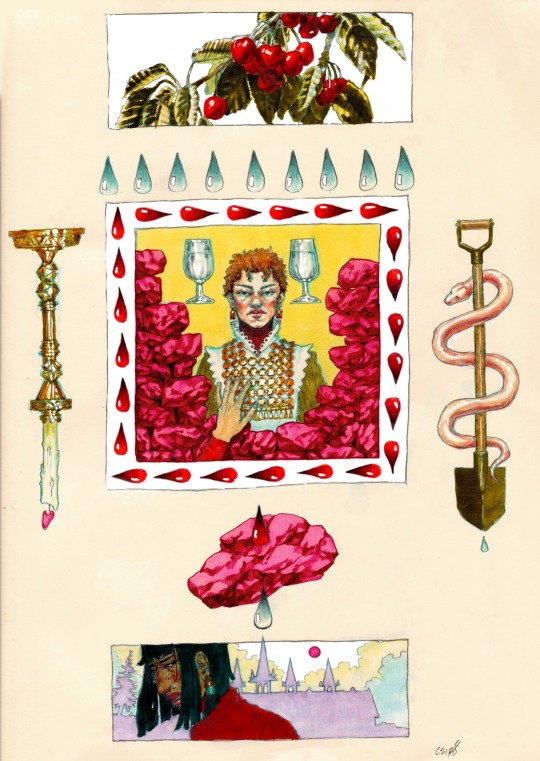
“Hajnalka, martyred for the healing springs”
They hung a tapestry on the wall where Hajnalka had been immured. Five red loops were hooked on five big masonry nails wedged between stones. Woven from glittering silk thread was a lion hiding from the hunt, it’s hide bloodied with golden arrows. Above the cowering beast were tall oaks whose branches cradled jewel-colored birds. They looked down upon the lion with bland faces made of countless, tiny knots. Between trunks peered the gazes and noses of hounds and up a hill in the distance were the mounted riders with their harried horses, eyes rolling and bit chomping.
Anytime someone walked past, the textile would ripple with slight breeze. Piroska was reminded of Hajnalka’s last martyred breaths as air shivered fringe. It made her feel sick.
It was after breakfast on a mid autumn morning when Piroska was summoned to the head nun’s quarters. She had to pass through that long stone hallway with its single tapestry to get there. Its rich colors waved as Piroska passed and it inspired pause.
Hajnalka had been a year older than Piroska with frightening hazel eyes and red, curly hair. The orphan of poor farming parents, it had been written in the will that the child be sent to monastery and their modest estate was donated to the church. Piroska visited the orchards that once belonged Hajnalka’s family every June to harvest the stone fruit that grew there. Soft, round white peaches and vibrant sour cherries would fill her wicker basket, and the nuns would turn blind eyes to the children as they indulged in the ripe fruit. Hajnalka would always vanish between those gnarled trunks and branches, gone until Piroska found them hunched in the sweet earth at a tree’s roots, wiping their eyes. She remembers sitting beside Hajnalka in the dappled light as the flies that ate at fallen fruit flesh made the air around thick with humming.
“My mother and father live in these trees.” They said after a while. The cherry Piroska had just bitten into felt suddenly over-sour. She forwent spitting out the pit by picking it gracelessly from her mouth and said a measly “I’m sorry.”
Piroska never met her parents. Her birth placed her right into the hands of the church, slid straight from the womb into her vestments. Only little glimpses of the outside world hinted at an existence beyond scriptures and daily prayer. Hajnalka was cut from the white cloth of peasants who came in from the fields to Mass, linen with little darned holes, embroidered red hems, and wide bell sleeves.
#my ocs#my art#illustration#artists on tumblr#illustrators on tumblr#lgbt art#lgbt comic#folklore#queer as folk#queer folktales#folktales#traditional art#traditional illustration#copic art#graphite art#storybook#fairy tales#writing#my writing#prose writing
5 notes
·
View notes
Photo

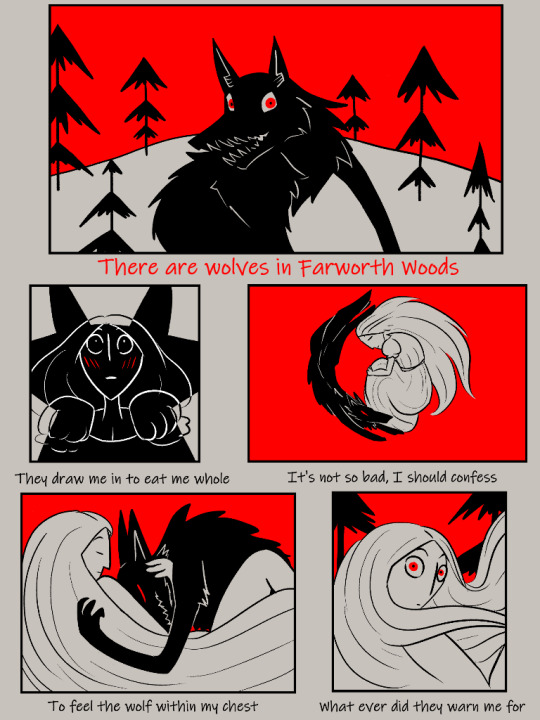

Wolves
#comic#digital comic#wolves#wolf#werewolf#lesbian werewolves#queer#queer comic#wolf comic#original comic#sparkle art#folktale#folktale comic
2K notes
·
View notes
Text
Do you love fairy tales? I want to hear from you!
EDIT: I will be closing the survey on November 9th! Thank you everyone who has participated!!!
My name is Ainjel Stephens and I am a PhD candidate in the Folklore department at Memorial University of Newfoundland. I am currently conducting a research project on fairy tales reception by queer-identifying individuals for my PhD dissertation under the supervision of Sarah Gordon. The purpose of this study is to learn how people who feel queer or identify as queer think about and respond to fairy tales.

Artist: Gustave Dore
If this sounds like a project you would be interested in participating in, then I invite you to take a short survey where you will be asked a few questions about who you are, as well as reflective questions about your thoughts and feelings on fairy tales, and if these tales are “queer.” It should only take about 10 minutes of your time to complete.
The survey asks if you would like to participate further with an interview with myself in order to discuss your thoughts and opinions on fairy tales. This interview will be a recorded hour-long interview through video conferencing platform Tauria or Webex. If you select yes, I will be in contact with you with further steps. If you select no, then that’s it! Thank you for participating.
To participate, you must be the age of majority and no younger than 19, have fairy tale knowledge in English, and identify with the term “queer.”
If you are interested, click the link below to participate in the anonymous survey.
If you have questions or want to chat further, you can contact me at [email protected] or through my inbox on my project blog, www.diamondsandtoads.tumblr.com/
If you know anyone who may be interested in participating in this study, please send this post along.
Thank you for reading!
The proposal for this research has been reviewed by the Interdisciplinary Committee on Ethics in Human Research and found to be in compliance with Memorial University’s ethics policy. If you have ethical concerns about the research, such as your rights as a participant, you may contact the Chairperson of the ICEHR at [email protected] or by telephone at 709-864-2861
#fairytales#fairy tale retelling#queer#lgbt#lgbtq community#beauty and the beast#cinderella#little red riding hood#charles perrault#grimms#grimm fairy tales#queer fairy tale#diamonds and toads#folklore#folktale#snow white#sleeping beauty#queer writers#queer community#lgbt community#the princesses#academia#queer fairytales
258 notes
·
View notes
Text
Unexpected horror unlocked: folks keep asking me to recommend books, often by tying them back to my own book in some way. I am now forced to to contend with queer historical maritime folktales being rather niche, alongside the fact that anytime someone asks me what books I have read recently my immediate response is "I have never seen a book in my life, what the fuck is a book"
#in my life#laughing at myself honestly#I mean this should not be so hard#and yet#I can think of quite a few queer historicals#and there are definitely lots of queer riffs on folktales#but I'm struggling to come up with books that are both#especially since I have been doing way more writing than reading the past few years#I have a few that sound really cool on my TBR that I'm looking forward to!
12 notes
·
View notes
Text
The Lovers’ Journey of Bill & Frank: A Folktale Analysis

Based on Dr. Clarissa Pinkola Estés’ Women Who Run With the Wolves; Adapted from my Twitter thread
"Wise stories... describe love as a union of two beings whose strength together enables one or both to enter into communication with the soul-world and to participate in fate as a dance with life and death."
- Chapter 5, Hunting: When the Heart is a Lonely Hunter, Dr. Estés
In her retelling of The Skeleton Woman, Dr. Estés describes the titular character as the third party in any romance, Lady Death, who represents the Life/Death/Life cycle with which the lovers must be in communion if they hope to have any longevity. She lays out the story's 7 steps to lasting love (though the order may vary):
Accidental Finding of Treasure
Chase and the Hiding
Untangling the Skeleton
Sleep of Trust
Giving the Tear
Heart as Drum, and Singing Up
Dance of Body and Soul
In #TheLastOfUs Episode 3, we see Bill & Frank experience all of these stages together, passing from life to death and back again through their love for one another, and by accepting both life and death, they achieve a love that is eternal.
The story starts with both lovers symbolically dead: Bill is living alone in his compound, effectively locked into his own tomb, and he discovers Frank in the pit he dug; in other words, in a grave. Bill approaches Frank like prey: the heart is a lonely hunter, indeed. Now the Accidental Finding of Treasure: Bill finds Frank in the <grave> and is not aware at first of what he has found. He is fearful of this stranger and wants to cut him loose, just as the story's hunter wants to release the Skeleton Woman when he catches her in his net.
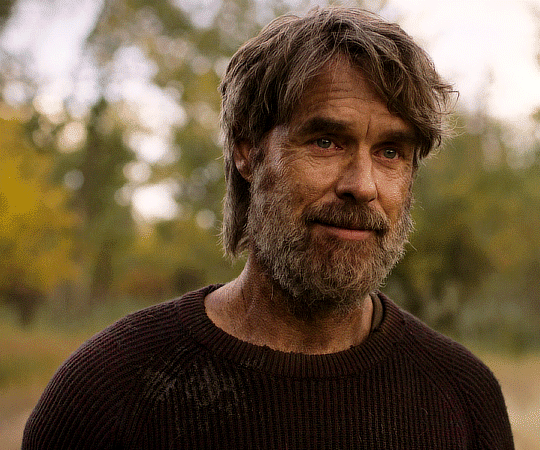
Next, the Chase and the Hiding: Because the hungry Skeleton Woman eats food of the mortal world, I also consider this step to be the sharing of food, which is a common way mythical lovers lay claim to one another. Hungry Frank eats of Bill's food, and thus becomes tied to him. Bill is quite literally followed home by this unexpected sack of bones and he feeds him, yet at the same time, Bill is hiding from Frank (and likely from himself, as it seems Bill has been deeply closeted all his life).
The next stage, Untangling the Skeleton, is performed by both men as they try to tease out who the other is. Frank notices Bill's care with food and wine, as well as his piano, as Bill tries to determine whether Frank can be trusted. They arrange one another's bones in order.
The Sleep of Trust symbolically occurs each time Bill chooses to trust Frank during their first encounter: first when he allows Frank to use his shower, again when he cooks for him, lets him play the piano, and finally when he showers himself, leaving Frank unattended.
Giving the Tear is a more literal stage for these lovers, as they both become visibly emotional when they connect over music. Further, their desperate desire is a type of thirst, just like the thirsty Skeleton Woman who drinks the Hunter's gift of a tear.
The next stage, Heart as Drum and Singing Up, is my favorite and the one most distinct to the Skeleton Woman tale. In the story, she takes the heart from the Hunter's chest and beats it like a drum, singing flesh onto her bones through the soul-song they share. And indeed, Frank correctly identifies the song of Bill's heart, his soul song, and beats the piano like a drum, singing flesh onto Bill's dried-up bones. It's clear when Bill plays that it is the first time he has done so in a... Long, Long Time.
All of this gradual acceptance of Life by two symbolically dead men leads to their eventual consummation, the Dance of Body and Soul. This is why their scene of intimacy is necessary to their story - we MUST see them return from death to life. But of course, their story is not yet over. They have accepted Life, but now they must also accept Death. The Lovers' Journey of their meeting is followed by the longer Lovers' Journey of their lifetimes, and they gradually pass through all the stages again.
Briefly, this second journey goes:
Accidental Finding of Treasure = Frank chooses to stay
Chase and Hiding = Frank making his mark on their home, drawing Bill out of his shell
Untangling the Skeleton = Making friends, growing together
Sleep of Trust = Bill's gunshot wound
Giving the Tear = Acknowledging Frank's inevitable death
Heart as Drum and Singing Up = Marriage (again with the soul song)
Dance of Body and Soul = Passing on together
In the second half of their journey, they accept that they will return to death from life, and embrace it. Finally, after their deaths, Bill passes the lesson he has learned to Joel, telling him that to love is to live. This will inspire Joel to protect Ellie with all that he has, ensuring the cycle of life will continue.

Thank you #TheLastOfUs for this beautiful love story!
#the last of us#the last of us hbo#tlou#tlou show#tlou meta#meta#bill x frank#mlm#joel miller#ellie miller#women who run with the wolves#clarissa pinkola estes#skeleton woman#lady death#life death life cycle#folktale#queer folk tale#folk tale#folktale analysis#tlou analysis#long long time#tlou ep 3#tlou episode 3 spoilers#tlou episode 3#the last of us ep 3#the last of us episode 3#linda ronstadt#soul song
63 notes
·
View notes
Text

Gnomevember 2023, fourteen
“Ink.”
Continuing with Folktale Week as well, and though folktales come from oral tradition first and foremost, may we honor and invoke the ink in which all books of such stories are written, nowadays.
Featuring a common opening to German folktales, as collected from here.
“Back in the days when it was still of use to wish for a thing…”
And here are some other favorites, as collected from here (though note, if you check it out, the list is not the most politically correct.)
“‘Twas not in my time, ’twas not in your time, but it was in somebody’s time…” (Irish, what what!)
“It all happened long ago, and believe it or not, it is all absolutely true…” (Also Irish!)
“A story, a story, let it come, let it go…” (West African)
“Beyond seven mountain ranges, beyond seven rivers…” (Czech)
“Many years ago, in a time when memory was young…” (Indian)
“Long, long ago, soon after sky and earth had become separated so that there was room for trees to grow and the tribes of men to move between them, many gods and spirits still lived in the world…” (Maori)
“Now we are about to begin and you must attend! And when we get to the end of the story, you will know more than you do now.” (Andersen)
~
(Full prompt list from kristileighgillustration, of the ‘gram.)
~
Bonus art and stories ~ Prints, comics and more!
#gnomevember#folktale week#storybook#gnome#gnomes#faerie#magic#fairy tales#faerie tales#drawing challenge#indie comics#queer comics#bonus art#body posi art#tock the gnome#ooh shiny
8 notes
·
View notes
Text


Happy birthday gayboy
#Ludwig ii#ludwig ii of bavaria#queer history#history art#19th century#I was drawing historical figures in thrift store finds and this is MY favourite dress#For anyone whos interested it's a dancing dress depicting the folktale of the children of lir#I feel like hed be into the whole cultural legend aspect and Of Course The Swans so
16 notes
·
View notes
Text
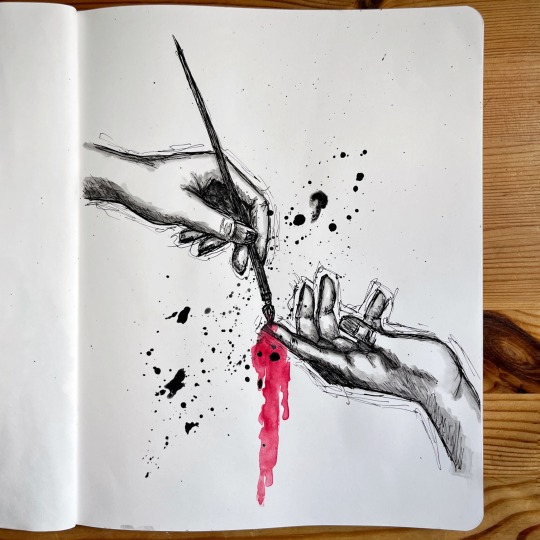
folktale week day 2: ink ✦ scratchy loose fast work with a dip pen, water on the page to make the ink bleed, and a bit of watercolour. i have a love/hate relationship with drawing hands.
#folktale week#folktale week ink#traditional media#ink drawing#sketchbook drawing#dip pen#my art#artists on tumblr#queer artist
3 notes
·
View notes
Text
Duck Prints Press Celebrates Folktales and Fables Week with Our Favorite Folktale-Inspired (often Queer) Fiction

This week, March 19th to 25th, is World Folktales and Fables Week! Duck Prints Press is celebrating with two blog posts: yesterday’s, which focused on the folktales, fables, and myths that influenced us as creators, and today’s, about our favorite folktale-inspired fiction (queer and otherwise).
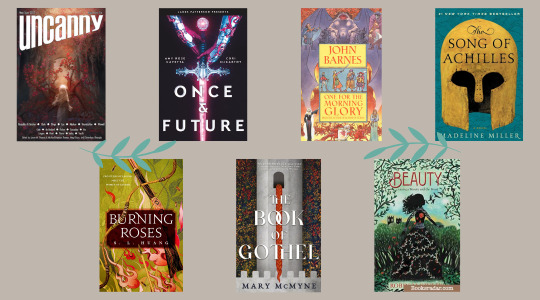
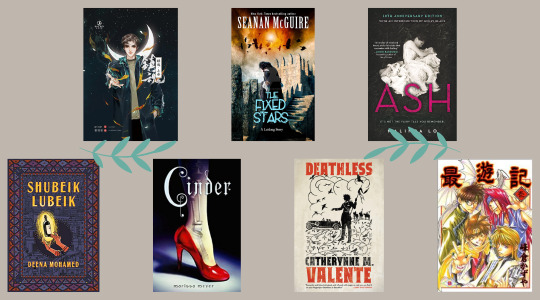
Two Hands, Wrapped in Gold by S.B. Divya (suggested by Dei)
This past year I read this story in Uncanny Magazine Issue 46, and it’s really stuck with me. It’s a retelling of a folktale very familiar to many Westerners, and the changes made turn it into a very compelling new story all on its own. No spoilers on what story it is, but suffice to say it takes a new perspective and I love this piece to bits.
Once & Future by Cory McCarthy and A. R. Capetta (suggested by Tris Lawrence)
I’m currently really enjoying the duology by Amy Rose Capetta and Cori McCarthy which is an Arthurian retelling in space with a female Arthur and multiple queer rep. It’s YA, and it’s just… fun? I love how it played with the the known pieces, and plays with Merlin’s aging backwards, and works to both fit within the expected and turn things around at the same time.
I’ve finished Once & Future (in Space) and just received Sword in the Stars (confronting the past) and can’t wait to get to read it after I finish what I’m already reading.
One For the Morning Glory by John Barnes (suggested by Nina Waters)
My favorite folktale-inspired book is John Barnes’s One for the Morning Glory. It’s just beautiful.
The Song of Achilles by Madeline Miller (suggested by Owlish)
Unfortunately, it does have a major character death because…well… Achilles. It is so beautifully written, though.
Burning Roses by S. L. Huang (suggested by Shadaras)
This novella takes inspiration from the fairytale Red Riding Hood and the legend of Hou Yi (as well as other classic Germanic fairy tales and Chinese legends!), and imagines both of those characters as middle-aged women uncertain of their place in the world. They travel together, fighting monsters, and tell each other about their youths and families (both of them have wives and children). The ending is happy, but the path there takes time and reflection from everyone involved. I love it because of how it blends two wholly separate mythologies together into one cohesive world, as well as for showing what might happen after the stories we know end.
The Book of Gothel by Mary McMyne (suggested by Owlish)
It’s a feminist retelling of Repunzel from the point of view of Mother Gothel setting her story straight.
Robin McKinley’s Fairy Tale Novels (suggested by E C)
Robin McKinley’s fairy tale novels are beautifully written (but sometimes brutal) retellings of some classic stories.
Guardian/Zhen Hun/镇魂 by Priest (suggested by boneturtle)
A danmei featuring humans, ghosts, demons, zombie kings, and all sorts of otherworldly creatures all wrapped up in an apocalyptic chinese folktale mashup from the master herself. taught me that 1) you are allowed to play with your own mythology, 2) fairytales are gay, 3) the apocalypse isn’t the end, just another spin of the wheel.
October Daye Series by Seanan McGuire (suggested by Sebastian Marie)
I love this series, there’s like eleven books, the first being Rosemary and Rue. They’re inspired by Irish folklore concerning the Faerie people.
Ash by Malinda Lo (suggested by E C)
“Ash” by Malinda Lo is a very queer Cinderella retelling.
Shubeik Lubeik by Deena Mohamed (suggested by Adrian Harley)
A gorgeous graphic novel of the modern world, but where wishes are a commodity, bought, sold, and processed. The graphic novel follows three people who come into possession of a “first-class” wish and their intertwining tales. It’s a beautiful exploration on a global and personal scale (what does colonialism look like in this world? How does law enforcement treat those who are seen as unworthy of having wishes? But also, if you’re a queer college student with major depression, what do you wish for to fix the mountain you feel crushing you? Are you even worthy of a wish?)—and it’s also really funny! I cannot say enough good things about this book, because I discovered it by chance on my library shelf last month and want everyone to know about it.
The Lunar Chronicles Series by Marissa Meyer (suggested by E C)
It’s sci-fi that brings Cinderella, Snow White, Red Riding Hood, and Rapunzel characters into the same universe.
Deathless by Catherynne M. Valente (suggested by Anonymous)
[[[A retelling of a Russian folk tale about Koschei the Deathless.]]]
Saiyuki by Kazuya Minekura (suggested by Anonymous)
It’s a manga with a distinctly retro anime-style retelling of the Journey to the West that bluntly confronts themes of loss, grief, redemption, and the long, long road to admitting you care about other people. It’s been on and off hiatus for years due to the author’s poor health, but I still adore it. This series taught me that it’s the journey that matters, not the destination.
Bonus!
The Mists of Avalon by Marion Zimmer Bradley (an inspiration to multiple people, suggested by multiple people)
When we asked our contributors to suggest the folktales and fables that inspired them, and their favorite folktale-inspired stories, The Mists of Avalon ended up getting nominated in both categories!
boneturtle said: retelling of Arthurian legend from Morgana’s POV. Not explicitly queer but features the women of the story with the men as sort of incidental, and given to me by my bi friend who said it helped her understand her own sexuality. and it’s beautifully, beautifully written.
-
There’s a wonderful number of fiction stories, novellas, novels, and series inspired by folktales and fables, and a growing number of those are queer. Have you got a favorite we didn’t mention? We’d love to hear about it!!
Who we are: Duck Prints Press LLC is an independent publisher based in New York State. Our founding vision is to help fanfiction authors navigate the complex process of bringing their original works from first draft to print, culminating in publishing their work under our imprint. We are particularly dedicated to working with queer authors and publishing stories featuring characters from across the LGBTQIA+ spectrum. Love what we do? Want to make sure you don’t miss the announcement for future giveaways? Sign up for our monthly newsletter and get previews, behind-the-scenes information, coupons, and more!
Want to support the Press, read about us behind-the-scenes, learn about what’s coming down the pipeline, get exclusive teasers, and claim free stories? Back us on Patreon or ko-fi monthly!
16 notes
·
View notes
Link
by Flora X. Tang
We can think of Sts. Sergius and Bacchus, Roman soldiers and Christian martyrs in the late third century, venerated by queer Catholics as models of same-sex love in early Christianity. Or we can think of Sts. Perpetua and Felicity, second-century Egyptian women martyrs known for their deep love for one another. St. Joan of Arc's cross-dressing in male uniform, along with her martyrdom at the hands of the church, allowed many to venerate her as a trans or gender-nonconforming saint. The third-century martyr St. Sebastian is known as a symbol of male beauty and homoerotic desire.
The list goes on. Biblical passages telling the stories of close intimacy between Ruth and Naomi or David and Jonathan are often proclaimed at queer Christian weddings. Icons of Perpetua and Felicity by Br. Robert Lentz began appearing in queer circles and official Catholic stores alike since the 1990s, alluding to these and other saints' queerness without openly ever claiming so.
13 notes
·
View notes
Text
I have THREE writing ideas, but I don't like any of them enough right now to actually...write them
(these are all just vague ideas that are living in the soup of my brain)
One's about an AI alone in a ship travelling close to c
another's about a person finding...notes and theatre tickets in their pockets that have time-travelled from like, the 80s? about queer history(...?)
The third's a collection of folktales built around a lighthouse (again) recorded as the world is about to end
#if anyone's actually interested in any of these come shout at me and maybe I'll write it#All of them are queer of course#just in totally different ways#speculative fiction my beloved#I have the most plot for the AI and the least for queer history#and folktales in a lighthouse is mostly about teh vibes and falling in love despite everything
7 notes
·
View notes
Text
I love mccafferty but I hate nick hartcop
#folk punk#pansexuel#emo music#rawring twenties#rawr xd#folk horror#queer as folk#folktale#midwest emo#myspace#post hardcore
8 notes
·
View notes
Text
love fairy tales? I want to talk to you!
I am a PhD student in folklore at Memorial University in Newfoundland and I am just starting to develop my dissertation project on fairy tales. I am just trying to get some feelers out and see if anyone would be interested in helping me with my project!
Basically, I want to hear about what people who self identify as queer or LGBT+ think about fairy tales, and queer representation or lack thereof in fairy tales.
If you might be interested, or know someone who might be, feel free to reply, reblog, like this post or send me a message (or if you just want to chat fairy tales!!!!).
(don’t worry, everything stays between us because I am not actually researching yet, I am just seeing if there is interest!!)
Thanks!

Here is an image from the tale The Princesses, or Diamonds and Toads, by Charles Perrault. I love her face in this one haha.
#fairytales#queer fiction#queer#queer fairy tale#diamonds and toads#folklore#the little mermaid#cinderella#snow white#charles Perrault#grimms#sleeping beauty#folktales#gay fairy tale#lgbtq community#academia#fairy tale retelling#queer community#queer writers#little red riding hood#the Princesses#project#update
111 notes
·
View notes
Text

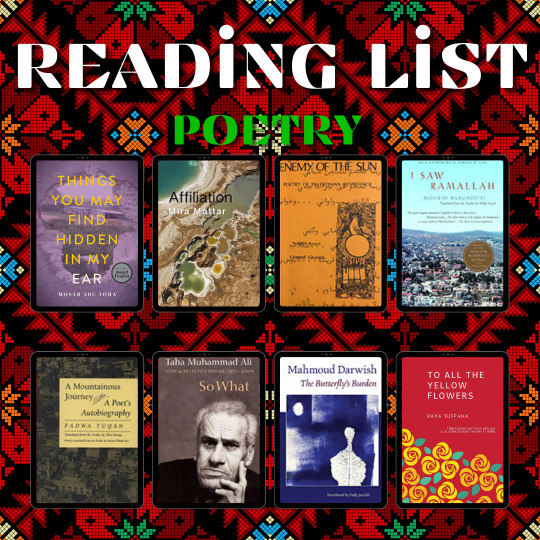

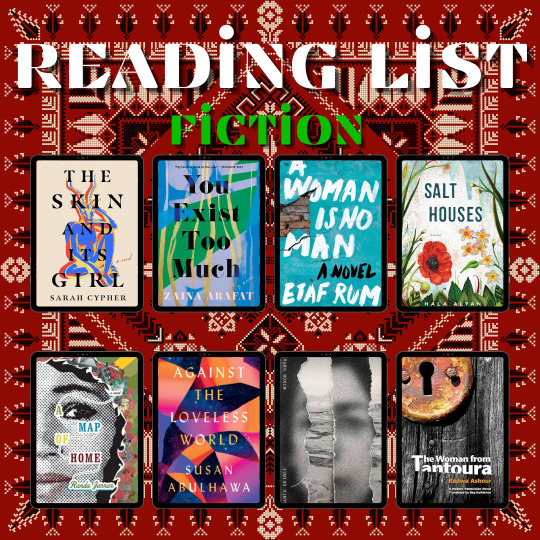




Read Palestine Week
🇵🇸 Good morning, my beautiful bookish bats. Can I start by saying a huge THANK YOU for sharing my Queer Palestinian Book post? Seriously, thank you so much. Let's keep that momentum by observing Read Palestine Week (Nov 29 - Dec 5). I've compiled a list of books to help you, along with a list of upcoming events and resources you can use this week and beyond.
🇵🇸 A collective of over 350 global publishers and individuals issued a public statement expressing solidarity with the Palestinian people. Publishers for Palestine have organized an international #ReadPalestine week, starting today (International Day of Solidarity with the Palestinian People).
🇵🇸 These publishers have made many resources and e-books available for free (with more to come). A few include award-winning fiction and poetry by Palestinian and Palestinian diaspora authors. You'll also find non-fiction books about Palestinian history, politics, arts, culture, and “books about organizing, resistance, and solidarity for a Free Palestine.” You can visit publishersforpalestine.org to download some of the books they have available.
POETRY
🌙 Things You May Find Hidden in My Ear by Mosab Abu Toha
🌙 Affiliation by Mira Mattar
🌙 Enemy of the Sun by Samih al-Qasim
🌙 I Saw Ramallah by Mourid Barghouti
🌙 A Mountainous Journey by Fadwa Tuqan
🌙 So What by Taha Muhammad Ali
🌙 The Butterfly’s Burden by Mahmoud Darwish
🌙 To All the Yellow Flowers by Raya Tuffaha
FICTION
🌙 Gate of the Sun by Elias Khoury
🌙 Speak, Bird, Speak Again: Palestinian Arab Folktales
🌙 Men in the Sun by Ghassan Kanafani
🌙 Morning in Jenin by Susan Abulhawa
🌙 Gaze Writes Back by Young Writers in Gaze
🌙 Palestine +100:Stories from a Century after the Nakba
🌙 Wild Thorns by Sahar Khalifeh
🌙 Out of Time by Samira Azzam
🌙 The Skin and Its Girl by Sarah Cypher
🌙 You Exist Too Much by Zaina Arafat
🌙 A Woman is No Man by Etaf Rum
🌙 Salt Houses by Hala Alyan
🌙 A Map of Home by Randa Jarrar
🌙 Against the Loveless World by Susan Abulhawa
🌙 Minor Detail by Adania Shibli
🌙 The Woman From Tantoura by Radwa Ashour
NON-FICTION
🌙 Blood Brothers by Elias Chacour
🌙 Strangers in the House: Coming of Age in Occupied Palestine by Raja Shehadeh
🌙 Palestinian Art, 1850–2005 by Kamal Boullata
🌙 Palestine by Joe Sacco
🌙 The Hour of Sunlight: One Palestinian’s Journey from Prisoner to Peacemaker by Sami Al Jundi & Jen Marlowe
🌙 Palestine: A Four Thousand Year History by Nur Masalha
🌙 Justice for Some: Law and the Question of Palestine by Noura Erakat
🌙 The Words of My Father: Love and Pain in Palestine by Yousef Khalil Bashir
🌙 Traditional Palestinian Costume: Origins and Evolution by Hanan Karaman Munayyer
🌙 Mountain against the Sea: Essays on Palestinian Society and Culture by Salim Tamari
🌙 This Is Not a Border: Reportage and Reflection from the Palestine Festival of Literature
🌙 We Could Have Been Friends, My Father and I: A Palestinian Memoir, by Raja Shehadeh
🌙 Les échos de la mémoire. Une enfance palestinienne à Jérusalem, by Issa J. Boullata
🌙 A Party For Thaera: Palestinian Women Write Life In Prison
🌙 Light in Gaza: Writings Born of Fire,
🌙 Voices of the Nakba: A Living History of Palestine
#free palestine#save palestine#books#book list#book recs#book recommendation#booklr#book blog#batty about books#battyaboutbooks#arab american heritage month#arab american writers#palestinian writers#palestinian poetry#poetry#poetry books#nonfiction#fiction books#queer fiction#queer community#queer books#muslim writers#read palestine week
212 notes
·
View notes